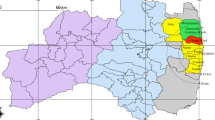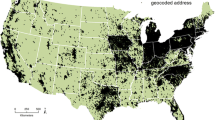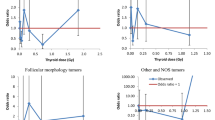Abstract
This study evaluates the reliability of information obtained by standardized questionnaires used in by personal interviews for estimation of radiation thyroid doses of 1065 individuals in the Belarusian cohort of individuals who were exposed in utero and early life following the Chernobyl accident in April 1986. Data from two interviews conducted in 2012–2017 and in 2018–2022 with mothers, who were pregnant or gave birth shortly after the Chernobyl accident, were analysed. The most reliable answers dealt with various attributes related to residential history. In contrast, the reliability of answers regarding consumption rates of milk from privately owned cows or trade network was moderate, while the agreement in responses for consumption of milk products and leafy vegetables was fair. Information from the two interviews was used to calculate thyroid doses received by the cohort members. Specifically, ‘model-based’ thyroid doses due to 131I were estimated using input data on individual residential history and food consumption reported during the personal interviews and ecological data (131I ground deposition in the corresponding settlements). In addition, for a subset of cohort subjects (n = 205) whose mothers were measured for 131I thyroid activity, ‘measurement-based’ thyroid doses were calculated by adjusting the model-based dose using a scaling factor that is defined as the ratio of measured 131I thyroid activity to model-based 131I thyroid activity calculated for the date of measurement. A moderate agreement was observed for total (prenatal and postnatal) model-based thyroid doses due to 131I intake, the arithmetic mean ± standard deviation for the Jaccard similarity coefficient (\({J}_{sim}\)) was 0.45 ± 0.34 (median = 0.39), while measurement-based doses showed a much better agreement with a \({J}_{sim}\) of 0.78 ± 0.29 (median = 0.93). For model-based thyroid doses from external irradiation and from ingestion of 134Cs and 137Cs, \({J}_{sim}\) was 0.82 ± 0.23 (median = 0.90) and 0.84 ± 0.24 (median = 0.96), respectively. Measurement-based doses due to ingestion of radiocaesium isotopes resulted in an almost perfect agreement, \({J}_{sim}\) was 0.91 ± 0.19 (median = 1.0). The present findings suggest that long-term memory recall can be reliable, if a person is asked about unique or important life events, such as pregnancy and childbirth occurring around the time of a nuclear reactor accident. However, the substantial difference (more than 10 times) observed for model-bases doses calculated using the two questionnaires represents an important source of human factor uncertainties that needs to be considered in any dose response analyses. Other lessons learned from this study are that (i) individual measurements of radionuclides in the human body are the most valuable source of information for estimating radiation doses, and (ii) whenever a radiation accident occurs, a sample of affected people should be asked to keep a diary, if at all possible.


Similar content being viewed by others
References
Babel P (2017) The influence of state and trait anxiety on the memory of pain. Pain Med 18:2340–2349
Baranowski T, Islam N, Baranowski J, Martin S, Beltran A, Dadabhoy H, Adame SH, Watson KB, Thompson D, Cullen KW, Subar AF (2012) Comparison of a Web-based versus traditional diet recall among children. J Acad Nutr Diet 112:527–532
Burrows TL, Martin RJ, Collins CE (2010) A systematic review of the validity of dietary assessment methods in children when compared with the method of doubly labeled water. J Am Diet Assoc 110:1501–1510
Cui Q, Xia Y, Wu Q, Chang Q, Niu K, Zhao Y (2021) A meta-analysis of the reproducibility of food frequency questionnaires in nutritional epidemiological studies. Int J Behav Nutr Phys Act 18:12
Da Costa D, Larouche J, Dritsa M, Brender W (1999) Variations in stress levels over the course of pregnancy: factors associated with elevated hassles, state anxiety and pregnancy-specific stress. J Psychosom Res 47:609–621
Drozdovitch V, Minenko V, Khrouch V, Leshcheva S, Gavrilin Yu, Khrutchinsky A, Kukhta T, Kutsen S, Luckyanov N, Shinkarev S, Tretyakevich S, Trofimik S, Voillequé P, Bouville A (2013) Thyroid dose estimates for a cohort of Belarusian children exposed to radiation from the Chernobyl accident. Radiat Res 179:597–609
Drozdovitch V, Kukhta T, Minenko V, Trofimik S, Bouville A, Potischman N (2016) Reliability of questionnaire data in the distant past: relevance for radiation exposure assessment. Health Phys 110:74–92
Drozdovitch V, Minenko V, Kukhta T, Trofimik S, Grakovitch R, Hatch M, Cahoon E, Veyalkin I, Polyanskaya O, Yauseyenka V, Ostroumova E, Mabuchi K, Rozhko A (2020) Thyroid dose estimates for a cohort of Belarusian persons exposed in utero and during early life to Chernobyl fallout. Health Phys 118:170–184
Drozdovitch V, Chizhov K, Chumak V, Bakhanova E, Trotsyuk N, Bondarenko P, Golovanov I, Kryuchkov V (2022a) Reliability of questionnaire-based dose reconstruction: human factor uncertainties in the radiation dosimetry of Chernobyl cleanup workers. Radiat Res 198:172–180
Drozdovitch V, Kukhta T, Trofimik S, Melo D, Viarenich K, Podgaiskaya M, Minenko V (2022b) Doses from external irradiation and ingestion of 134Cs, 137Cs and 90Sr to the population of Belarus accumulated over 35 years after the Chernobyl accident. Radiat Environ Biophys 61:445–464
Dwyer JT, Coleman KA (1997) Insights into dietary recall from a longitudinal study: accuracy over four decades. Am J Clin Nutr 65:1153S-1158S
Eysenck MW, Derakshan N, Santos R, Calvo MG (2007) Anxiety and cognitive performance: attentional control theory. Emotion 7:336–353
Friedenreich CM (1994) Improving long-term recall in epidemiologic studies. Epidemiology 5:1–4
International Commission on Radiological Protection (2001) Doses to the embryo and fetus from intakes of radionuclides by the mother. ICRP Publication 88. Ann ICRP 31(1–3).
International Commission on Radiological Protection (2010) Conversion coefficients for radiological protection quantities for external radiation exposures. ICRP Publication 116. Ann ICRP 40(2–5).
Jaccard P (1912) The distribution of the flora in the Alpine zone. New Phytol 11:37–50
Kukhta T, Minenko V, Trofimik S, Drozdovitch V (2021) Reliability of thyroid doses due to 131I intake exceeding 5 Gy in a cohort of Belarusian children exposed to Chernobyl fallout. Radiat Environ Biophys 60:179–191
Landis JR, Koch GG (1977) The measurement of observer agreement for categorical data. Biometrics 33:159–174
Lee-Han H, McGuire V, Boyd NF (1989) A review of the methods used by studies of dietary measurement. J Clin Epidemiol 42:269–279
Marshall JR (2005) Commentary: about that measurement problem. Int J Epidemiol 34:1376–1377
Minenko V, Ulanovsky A, Drozdovitch V, Shemiakina E, Gavrilin Yu, Khrouch V, Shinkarev S, Bouville A, Anspaugh LR, Voillequé P (2006) Individual thyroid dose estimation for a case-control study of Chernobyl-related thyroid cancer among children of Belarus—Part II: contribution from long-lived radionuclides and external radiation. Health Phys 90:312–327
Priyambada K, Pattojoshi A, Bakhla AK (2017) A study of antenatal anxiety: comparison across trimesters. Int J Reprod Contracept Obstet Gynecol 6:1810–1813
Ratner B (2009) The correlation coefficient: its values range between +1/−1, or do they? J Target Meas Anal Mark 17:139–142
Riboli E, Toniolo P, Kaas R, Shore RE, Casagrande C, Pasternack DS (1997) Reproducibility of a food frequency questionnaire used in the New York University Women’s Health Study: effect of self-selection by study subjects. Eur J Clin Nutr 51:437–442
Rohan TE, Potter JD (1984) Retrospective assessment of dietary intake. Am J Epidemiol 120:876–887
Simon SL, Luckyanov N, Bouville A, VanMiddlesworth L, Weinstock RM (2002) Transfer of 131I into human breast milk and transfer coefficients for radiological dose assessments. Health Phys 82:796–806
Wu ML, Whittemore AS, Jung DL (1988) Errors in reported dietary intakes. II. Long-term recall. Am J Epidemiol 128:1137–1145
Yauseyenka V, Drozdovitch V, Ostroumova E, Polyanskaya O, Minenko V, Brenner A, Hatch M, Little MP, Cahoon EK, Kukhta T, Starastsenka L, Grakovitch R, Cheshik A, Veyalkin I, Rozhko A, Mabuchi K (2020) Belarusian in utero cohort: A new opportunity to evaluate the health effects of prenatal and early-life exposure to ionizing radiation. J Radiol Prot 40:280–295
Funding
This work was supported by the Intra-Agency Agreement between the National Institute of Allergy and Infectious Diseases (NIAID, USA) and the National Cancer Institute (NCI, USA), NIAID agreement # DCC-OD-12-900, and by the Intramural Research Program of the Division of Cancer Epidemiology and Genetics, NCI, NIH (USA), within the framework of the Belarus-U.S. Study of Thyroid Cancer and Other Diseases Following the Chernobyl Accident (Protocol #OH95-C-NO21) through contracts HHSN261201300002C and HHSN261201800015C between the NCI and the Republican Research Center for Radiation Medicine and Human Ecology (Gomel, Belarus).
Author information
Authors and Affiliations
Contributions
VD designed the study. IV, VY and AR organized, conducted and supervised filed work for the tracing, contacting and interviewing of mothers. VM and ST calculated the radiation doses to the thyroid gland for the study subjects. VD and TK analyzed the data. VD, TK and KM wrote the manuscript. All authors reviewed the manuscript.
Corresponding author
Ethics declarations
Conflict of interest
The authors declare that this work was carried out in the absence of any personal, professional, or financial relationships that could potentially be construed as a conflict of interest.
Additional information
Publisher's Note
Springer Nature remains neutral with regard to jurisdictional claims in published maps and institutional affiliations.
Rights and permissions
About this article
Cite this article
Drozdovitch, V., Kukhta, T., Minenko, V. et al. Recall of residential history and dietary habits during pregnancy and lactation in the distant past: reliability of questionnaire-based radiation doses for persons exposed in utero and early life. Radiat Environ Biophys 62, 465–481 (2023). https://doi.org/10.1007/s00411-023-01040-5
Received:
Accepted:
Published:
Issue Date:
DOI: https://doi.org/10.1007/s00411-023-01040-5




